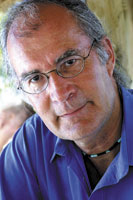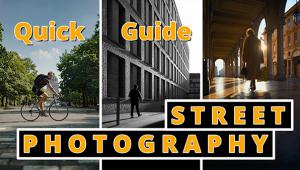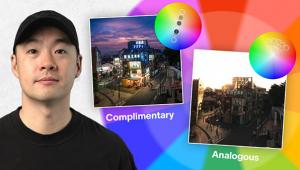Opening The Creative Door
Once upon a time we’d bring our roll of film into a lab and wait expectantly for the prints. Upon opening the envelope we’d be surprised or perhaps disappointed, but for the most part we’d accept what was given us, despite the fact that the sky was not as blue as we saw, or a face didn’t have quite the right tone. That was then. These days we have the right (some would say the duty) to make our images look the way we want, to become, if you will, custom printers and processors of our own digital images.
 These days it seems that the manipulation scenario goes back and forth between the camera settings and what we do in the computer. The microprocessors in cameras go through more processing steps than just integrating color and creating a final image. More and more in camera processors are offering so-called “art” options, ways of interpreting the image beyond aperture and shutter speed effects and bringing us results that are more or less vivid, that work with tonal curve adjustments, and even add effects that previously we’d get using plug-ins and special effects software.
These days it seems that the manipulation scenario goes back and forth between the camera settings and what we do in the computer. The microprocessors in cameras go through more processing steps than just integrating color and creating a final image. More and more in camera processors are offering so-called “art” options, ways of interpreting the image beyond aperture and shutter speed effects and bringing us results that are more or less vivid, that work with tonal curve adjustments, and even add effects that previously we’d get using plug-ins and special effects software.
Just as the borders between still and motion images are being blurred in the latest camera models, so are the number and variation of image effects being offered that allow you to tag an image at the moment of exposure. Indeed, with some Live View models you can preview them right on the LCD monitor before you snap the shutter. For example, one of the most amazing things I’ve seen is the ability to previsualize in black and white right on the monitor as you compose your images. This might seem commonplace to some, but to those who worked with black-and-white film it is revolutionary.
While there’s no doubt that making creative changes in “post” allows for more nuanced results, these latest “art” cameras certainly make for easier access to image effects that required sometimes expensive software and a steep learning curve to achieve.
The same goes for a large crop of software that can be used as a plug-in or “stand-alone” setup, where interface, single-step changes, and previews of results shown “live” as you work can all be done with relative ease. Almost every effect imaginable can be achieved without extensive training, making the digital image more malleable than anything we ever could do in the chemical darkroom.
Of course the problem is that we now have perhaps too many choices and ways to work the image. Do we make it a “straight” print, one that recreates all the texture, tone, and color of what we saw when we snapped the shutter, or do we take the image to the edge, and beyond? Those decisions are personal, and each image will have to tell its own story. But rather than get hung up on what is “real” and what is artifice, or the implications this holds for photography now and into the future, we should revel in the creative environment that we find ourselves in and admit that whatever boundaries we might have imagined for our photographs are constantly being reset. Having control over the creative possibilities opens many doors; choosing which one to enter is part of how we tell our own visual story.

 These days it seems that the manipulation scenario goes back and forth between the camera settings and what we do in the computer. The microprocessors in cameras go through more processing steps than just integrating color and creating a final image. More and more in camera processors are offering so-called “art” options, ways of interpreting the image beyond aperture and shutter speed effects and bringing us results that are more or less vivid, that work with tonal curve adjustments, and even add effects that previously we’d get using plug-ins and special effects software.
These days it seems that the manipulation scenario goes back and forth between the camera settings and what we do in the computer. The microprocessors in cameras go through more processing steps than just integrating color and creating a final image. More and more in camera processors are offering so-called “art” options, ways of interpreting the image beyond aperture and shutter speed effects and bringing us results that are more or less vivid, that work with tonal curve adjustments, and even add effects that previously we’d get using plug-ins and special effects software.Just as the borders between still and motion images are being blurred in the latest camera models, so are the number and variation of image effects being offered that allow you to tag an image at the moment of exposure. Indeed, with some Live View models you can preview them right on the LCD monitor before you snap the shutter. For example, one of the most amazing things I’ve seen is the ability to previsualize in black and white right on the monitor as you compose your images. This might seem commonplace to some, but to those who worked with black-and-white film it is revolutionary.
While there’s no doubt that making creative changes in “post” allows for more nuanced results, these latest “art” cameras certainly make for easier access to image effects that required sometimes expensive software and a steep learning curve to achieve.
The same goes for a large crop of software that can be used as a plug-in or “stand-alone” setup, where interface, single-step changes, and previews of results shown “live” as you work can all be done with relative ease. Almost every effect imaginable can be achieved without extensive training, making the digital image more malleable than anything we ever could do in the chemical darkroom.
Of course the problem is that we now have perhaps too many choices and ways to work the image. Do we make it a “straight” print, one that recreates all the texture, tone, and color of what we saw when we snapped the shutter, or do we take the image to the edge, and beyond? Those decisions are personal, and each image will have to tell its own story. But rather than get hung up on what is “real” and what is artifice, or the implications this holds for photography now and into the future, we should revel in the creative environment that we find ourselves in and admit that whatever boundaries we might have imagined for our photographs are constantly being reset. Having control over the creative possibilities opens many doors; choosing which one to enter is part of how we tell our own visual story.

- Log in or register to post comments

































